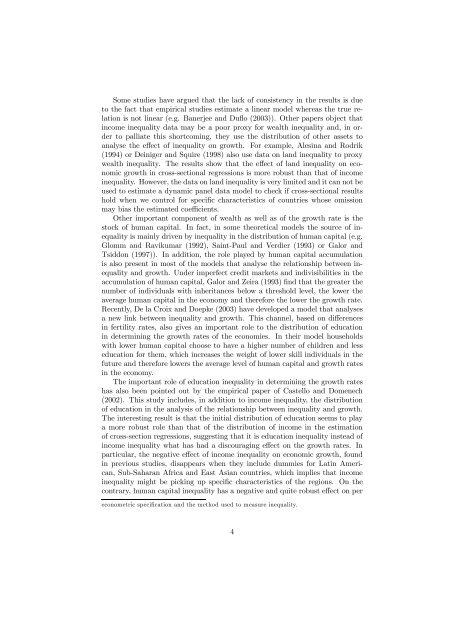Amparo Castelló-Climent, Universidad Carlos III de Madrid ... - Ivie
You also want an ePaper? Increase the reach of your titles
YUMPU automatically turns print PDFs into web optimized ePapers that Google loves.
Some studies have argued that the lack of consistency in the results is due<br />
to the fact that empirical studies estimate a linear mo<strong>de</strong>l whereas the true relation<br />
is not linear (e.g. Banerjee and Duflo (2003)). Other papers object that<br />
income inequality data may be a poor proxy for wealth inequality and, in or<strong>de</strong>r<br />
to palliate this shortcoming, they use the distribution of other assets to<br />
analyse the effect of inequality on growth. For example, Alesina and Rodrik<br />
(1994) or Deiniger and Squire (1998) also use data on land inequality to proxy<br />
wealth inequality. The results show that the effect of land inequality on economic<br />
growth in cross-sectional regressions is more robust than that of income<br />
inequality. However, the data on land inequality is very limited and it can not be<br />
used to estimate a dynamic panel data mo<strong>de</strong>l to check if cross-sectional results<br />
hold when we control for specific characteristics of countries whose omission<br />
may bias the estimated coefficients.<br />
Other important component of wealth as well as of the growth rate is the<br />
stock of human capital. In fact, in some theoretical mo<strong>de</strong>ls the source of inequality<br />
is mainly driven by inequality in the distribution of human capital (e.g.<br />
Glomm and Ravikumar (1992), Saint-Paul and Verdier (1993) or Galor and<br />
Tsiddon (1997)). In addition, the role played by human capital accumulation<br />
is also present in most of the mo<strong>de</strong>ls that analyse the relationship between inequality<br />
and growth. Un<strong>de</strong>r imperfect credit markets and indivisibilities in the<br />
accumulation of human capital, Galor and Zeira (1993) find that the greater the<br />
number of individuals with inheritances below a threshold level, the lower the<br />
average human capital in the economy and therefore the lower the growth rate.<br />
Recently, De la Croix and Doepke (2003) have <strong>de</strong>veloped a mo<strong>de</strong>l that analyses<br />
a new link between inequality and growth. This channel, based on differences<br />
in fertility rates, also gives an important role to the distribution of education<br />
in <strong>de</strong>termining the growth rates of the economies. In their mo<strong>de</strong>l households<br />
with lower human capital choose to have a higher number of children and less<br />
education for them, which increases the weight of lower skill individuals in the<br />
future and therefore lowers the average level of human capital and growth rates<br />
in the economy.<br />
The important role of education inequality in <strong>de</strong>termining the growth rates<br />
has also been pointed out by the empirical paper of Castello and Domenech<br />
(2002). This study inclu<strong>de</strong>s, in addition to income inequality, the distribution<br />
of education in the analysis of the relationship between inequality and growth.<br />
The interesting result is that the initial distribution of education seems to play<br />
a more robust role than that of the distribution of income in the estimation<br />
of cross-section regressions, suggesting that it is education inequality instead of<br />
income inequality what has had a discouraging effect on the growth rates. In<br />
particular, the negative effect of income inequality on economic growth, found<br />
in previous studies, disappears when they inclu<strong>de</strong> dummies for Latin American,<br />
Sub-Saharan Africa and East Asian countries, which implies that income<br />
inequality might be picking up specific characteristics of the regions. On the<br />
contrary, human capital inequality has a negative and quite robust effect on per<br />
econometric specification and the method used to measure inequality.<br />
4

















